| 18th Dynasty (263) 15180-1317BC | |
| In the history of Egypt the XVIIIth dynasty was golden era of prosperity and power of empire. Successors of Ahmose who expelled Hyksos’, carry on policy of expansions sending regularly war campaigns to Asia and expanding influences at south, in Nubia, gaining control over gold mines. Thus, the growing power of Egypt results in strong economical position of this country in contemporary world. Designed and performed with a flourish temples of gods’ cult, numerous fortresses in south and elaborated tombs in rock became symbol of that epoch. Under Amenhotep III the Egyptian empire grew in significance that will never happen again in future. However the wealth in royal court leads finally to religious schism under Akhenaten and this is beginning of Egyptian empire’s downfall. Weakness of Amenhotep III’s successors is exploited by kingdoms of Asia and Nubia which throw off Egyptian yoke. Under Horemheb, the last pharaoh of this dynasty, this decay is stopped, however the empire faces long way to its reconstitution. | |
|
Amose I |
|
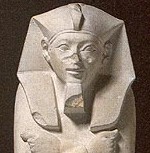 Son
of queen Ahhotep and Seqenenre Tao II, probably brother of Kamose -
the last rulers of dynasty XVII. Manetho assigned to him 25 years
and 4 months of rule. Analysis of his mummy revealed that at the
moment of death he was aged 35 so that Ahmose must have become a
pharaoh at the very young age. This might be possible considering
the early death of his father – Seqenenre, and brother – Kamose. In
18/19 year of rule (year 11 of Khamudi’s rule) he captured Awaris
and the fortress Scharuhen in southern Palestine after 3 years-siege
and thus completed act of restoration of Egyptian independence
definitely expulsing Hyksos. He broadened vastly Egyptian borders
making three successful campaigns in Nubia (after revolt of certain
Aata) and one in Asia. Ahmose restored an office of viceroy of Kush
and thus spread his own influence far to the south. He was brother
and husband of queen Ahmose-Nefertari, the mother of Amenhotep I.
Putative burial place – pyramid tomb in Biriabi, near Dra Abu
el-Naga in Western Thebes, although quite recently it is being
suggested that it might have been an unknown tomb KV32 in the Valley
of the Kings. The king’s mummy was discovered in the DB320 cache at
Deir el-Bahari. At Abydos he was build pyramid-enotaph (false tomb). Son
of queen Ahhotep and Seqenenre Tao II, probably brother of Kamose -
the last rulers of dynasty XVII. Manetho assigned to him 25 years
and 4 months of rule. Analysis of his mummy revealed that at the
moment of death he was aged 35 so that Ahmose must have become a
pharaoh at the very young age. This might be possible considering
the early death of his father – Seqenenre, and brother – Kamose. In
18/19 year of rule (year 11 of Khamudi’s rule) he captured Awaris
and the fortress Scharuhen in southern Palestine after 3 years-siege
and thus completed act of restoration of Egyptian independence
definitely expulsing Hyksos. He broadened vastly Egyptian borders
making three successful campaigns in Nubia (after revolt of certain
Aata) and one in Asia. Ahmose restored an office of viceroy of Kush
and thus spread his own influence far to the south. He was brother
and husband of queen Ahmose-Nefertari, the mother of Amenhotep I.
Putative burial place – pyramid tomb in Biriabi, near Dra Abu
el-Naga in Western Thebes, although quite recently it is being
suggested that it might have been an unknown tomb KV32 in the Valley
of the Kings. The king’s mummy was discovered in the DB320 cache at
Deir el-Bahari. At Abydos he was build pyramid-enotaph (false tomb).Other Dating 1570-1546
(Wente) |
|
|
Amenhotep I |
|
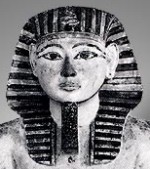 Son
of Ahmose by Ahmes-Nefertari. According to Manetho he ruled 20 years
and 7 months. He came to the throne after premature death of prince
Amenemhat, the heir to the throne. With his mother he was worshipped
at the Theban necropoly until the Late Period. He made wars in Asia,
Libya and Nubia from where he levied annual tributes. To him comes
the credit of renewing many temples alongside the Nile. He started
building of the temple at Karnak and Abydos, also temple of the
goddess Nekhbet at El-Kab and temples at Uronarti in Nubia and
Serabit el-Chadim at Synai. Tomb ANB near Dra el-Naga at Western
Thebes or tomb KV39 at the Valley of the Kings. Mummy of the king,
who diet at the age of 50 was found in the DB320 cache at Deir
el-Bahari. Son
of Ahmose by Ahmes-Nefertari. According to Manetho he ruled 20 years
and 7 months. He came to the throne after premature death of prince
Amenemhat, the heir to the throne. With his mother he was worshipped
at the Theban necropoly until the Late Period. He made wars in Asia,
Libya and Nubia from where he levied annual tributes. To him comes
the credit of renewing many temples alongside the Nile. He started
building of the temple at Karnak and Abydos, also temple of the
goddess Nekhbet at El-Kab and temples at Uronarti in Nubia and
Serabit el-Chadim at Synai. Tomb ANB near Dra el-Naga at Western
Thebes or tomb KV39 at the Valley of the Kings. Mummy of the king,
who diet at the age of 50 was found in the DB320 cache at Deir
el-Bahari.Other Dating 1551-1524
(Wente) |
|
|
Thutmose I |
|
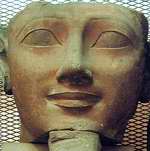 As
Totmes I was probably not related to ruling family he acquired
rights to the throne by marriage with king’s daughter, Ahmes who
bore him daughter – Hatshepsut (the later queen). For the lack of
male descendant from that marriage his heir to the throne became
Totmes II, the son of queen Mutnofret. There are many discrepancies
among Egyptologists as to length of Totmes’ rule. Opinion about
10-years rule is predominant. He vastly extended temple at Karnak.
Due to campaign against Nubia at the beginning of his rule, the
boundaries of Egypt moved as far as to Tombos, above the III
cataract. In his 4 or 5 year of rule he managed to reach Euphrates
in Asia and comemorized this victory with stele at Karkemish. In
Karnak he started large-scale works, he also left traces of building
activity at Elephantine, in Armant, Ombos, Abydos, Memfis and Nubia.
His burial place was the first hypogeum in the Valley of the Kings –
KV38. Mummy of the ruler was moved by Hatshepsut’s order to her
grave KV20 and then, after her death returned to its original burial
place by order of Totmes III. Mummy found in the DB320 cache at Deir
el-Bahari wasascribed to Totmes I. As
Totmes I was probably not related to ruling family he acquired
rights to the throne by marriage with king’s daughter, Ahmes who
bore him daughter – Hatshepsut (the later queen). For the lack of
male descendant from that marriage his heir to the throne became
Totmes II, the son of queen Mutnofret. There are many discrepancies
among Egyptologists as to length of Totmes’ rule. Opinion about
10-years rule is predominant. He vastly extended temple at Karnak.
Due to campaign against Nubia at the beginning of his rule, the
boundaries of Egypt moved as far as to Tombos, above the III
cataract. In his 4 or 5 year of rule he managed to reach Euphrates
in Asia and comemorized this victory with stele at Karkemish. In
Karnak he started large-scale works, he also left traces of building
activity at Elephantine, in Armant, Ombos, Abydos, Memfis and Nubia.
His burial place was the first hypogeum in the Valley of the Kings –
KV38. Mummy of the ruler was moved by Hatshepsut’s order to her
grave KV20 and then, after her death returned to its original burial
place by order of Totmes III. Mummy found in the DB320 cache at Deir
el-Bahari wasascribed to Totmes I.Other Dating 1525-1516
(Redford) |
|
|
Thutmose II |
|
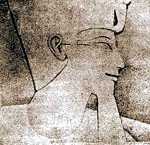 Son
of Totmes I and Mutnofret, he became king after death of his father
and his brothers Amenmose and Wadjmose. In German scholars’ opinion
(W.Helck, R.Krauss, E.Hornung) Totmes II ruled only 3-4 years.
Mantho’s Khebron was to rule 18 years but this seems to be
overestimated. He married his own sister, Hatshepsut and thus
legitimized the Totmes’ right to the throne. They had presumably two
daughters - Neferure and Neferubiti. His son and successor, Totmes
III, was born from his concubine Iset. He had to suppress revolts in
Nubia at least twice during his rule, he sent military expedition to
Asia as comemorized in inscription from Deir el-Bahari. Buildong
activities of the ruler are apparent mainly in Thebes and Nubia.
Burial place – tomb KV42 in the Valley of the Kings, that
construction was merely begun. Mummy of the king was found in the
DB320 cache at Deir el-Bahari. Son
of Totmes I and Mutnofret, he became king after death of his father
and his brothers Amenmose and Wadjmose. In German scholars’ opinion
(W.Helck, R.Krauss, E.Hornung) Totmes II ruled only 3-4 years.
Mantho’s Khebron was to rule 18 years but this seems to be
overestimated. He married his own sister, Hatshepsut and thus
legitimized the Totmes’ right to the throne. They had presumably two
daughters - Neferure and Neferubiti. His son and successor, Totmes
III, was born from his concubine Iset. He had to suppress revolts in
Nubia at least twice during his rule, he sent military expedition to
Asia as comemorized in inscription from Deir el-Bahari. Buildong
activities of the ruler are apparent mainly in Thebes and Nubia.
Burial place – tomb KV42 in the Valley of the Kings, that
construction was merely begun. Mummy of the king was found in the
DB320 cache at Deir el-Bahari.Other Dating 1518-1503
(Wente) |
|
|
Queen Hatshepsut |
|
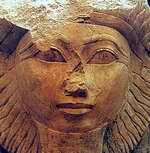 Daughter
of Tuthmosis I by queen Ahmes. She married her half-brother Tutmose
II. She overtook rule after death of her husband as she would not
let to pass it to her son-in-law Tuthmosis III, and reigned
initially as regent of the young heir to the throne, then as
pharaoh. Getting support from highly placed officials (Senenmut,
Hapuseneb, Djehuti, Nehsi) she managed to keep the young Tuthmosis
well in the background and announced herself a male pharaoh. There
is not agreement between scholars concerning the year of co-regency
with Tuthmosis III when Hatshepsut had proclaimed herself pharaoh.
Opinions of scholars diverge from 2 to 7 years. Change of the
titulary in jar inscriptions dated to the year 7 point at longer
period of co-regency. Inscription in Red Chapel of Hatshepsut at
Karnak, dated to year 2 suggest in turn shorter period. The
inscription mentions that the Oracle of Amun hailed Hatshepsut the
ruler of Egypt. During her reign she gave up policy of conquests in
favor of trade development. Expeditions to the land of Punt (first
one in the year 9 of her rule) resemble the policy of the Middle
Kingdom. According to D.B.Redford and W.F.Reinecke at least six war
or robbery campaigns in Nubia and Palestine could be also
documented. She ordered to erect many monuments, numerous obelisks
and magnificent mortuary temple at Deir el-Bahari, the last one was
being built almost 15 years. In works over this art of Egyptian
architecture was heavily involved Senenmut, the queen’s architect,
who had great influence on both the queen and her politics. She
celebrated her Sed festival in year 15 of the rule. Her successor
expunged any traces of her rule, after se died. He erased her
cartouches and images of her from all buildings she erected. Burial
place – tomb KV20 in the Valley of the Kings, where Hatshepsut was
buried although previously she had started to cut a tomb in wadi
cliff face, west of Deir el-Bahari. Moreover, she ordered to move
corpse of her father, Tuthmosis I, to her royal tomb in the Valley
of the Kings. Daughter
of Tuthmosis I by queen Ahmes. She married her half-brother Tutmose
II. She overtook rule after death of her husband as she would not
let to pass it to her son-in-law Tuthmosis III, and reigned
initially as regent of the young heir to the throne, then as
pharaoh. Getting support from highly placed officials (Senenmut,
Hapuseneb, Djehuti, Nehsi) she managed to keep the young Tuthmosis
well in the background and announced herself a male pharaoh. There
is not agreement between scholars concerning the year of co-regency
with Tuthmosis III when Hatshepsut had proclaimed herself pharaoh.
Opinions of scholars diverge from 2 to 7 years. Change of the
titulary in jar inscriptions dated to the year 7 point at longer
period of co-regency. Inscription in Red Chapel of Hatshepsut at
Karnak, dated to year 2 suggest in turn shorter period. The
inscription mentions that the Oracle of Amun hailed Hatshepsut the
ruler of Egypt. During her reign she gave up policy of conquests in
favor of trade development. Expeditions to the land of Punt (first
one in the year 9 of her rule) resemble the policy of the Middle
Kingdom. According to D.B.Redford and W.F.Reinecke at least six war
or robbery campaigns in Nubia and Palestine could be also
documented. She ordered to erect many monuments, numerous obelisks
and magnificent mortuary temple at Deir el-Bahari, the last one was
being built almost 15 years. In works over this art of Egyptian
architecture was heavily involved Senenmut, the queen’s architect,
who had great influence on both the queen and her politics. She
celebrated her Sed festival in year 15 of the rule. Her successor
expunged any traces of her rule, after se died. He erased her
cartouches and images of her from all buildings she erected. Burial
place – tomb KV20 in the Valley of the Kings, where Hatshepsut was
buried although previously she had started to cut a tomb in wadi
cliff face, west of Deir el-Bahari. Moreover, she ordered to move
corpse of her father, Tuthmosis I, to her royal tomb in the Valley
of the Kings.Other Dating 1503-1483
(Wente) |
|
|
Thutmose III |
|
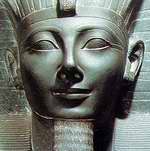 Son
of Totmes II and one of his wives – Iset. One of the most
outstanding rulers of Egypt. He was one of the greatest conquerors
in ancient times. Removed from power by his ambitious aunt he had to
wait until her death before he put into action his own military
plans. After he accessed the throne he assumed year of his father’s
death – 1504 as start point of his own rule thus omitting
Hatshepsut. He considered her usurper. Removed by her from rule in
presumably 2nd year (or slightly later) of coregency he held
priestly functions in temple. After Hatshepsut’ death he took rule
and ordered to destroy any traces of her illegal reign. In space of
only 20 years he lead 16 war campaigns to Asia as precisely stated
in Annales of Totmes at Karnak and numerous stele of victory as well
as biographies of officers participating in the king’s expeditions.
First expedition was organized within only few weeks after his
accessing the throne and was aimed against coalition of Syrian
princess. It was headed by prince Kadesh. The eight expedition in 33
year of rule succeeded in crossing Euphrates and significant
restricting of power of land of Mitanni. Next campaigns were mostly
the fights with Mitannian army and kept Egyptian dominance in Asia.
Egyptian empire extended from Euphrates in Asia to Napata in Upper
Nubia. Apart from military activities there are known trade
campaigns to Punt in year 33 of rule and to Sinai for turqoises.
Building activities of the ruler, carried on with a flourish no less
than war campaigns, is focused mainly in Karnak and West Thebes,
also in many places of Upper Egypt and Nubya. Three years before his
death he made his son, Amenhothep III the co-ruler. He died in the
last day of seventh month of 53rd year of his rule. Burial place –
tomb KV34 in Valley of the Kings. The king’s mummy was found in the
DB320 cache at Deir el-Bahari Son
of Totmes II and one of his wives – Iset. One of the most
outstanding rulers of Egypt. He was one of the greatest conquerors
in ancient times. Removed from power by his ambitious aunt he had to
wait until her death before he put into action his own military
plans. After he accessed the throne he assumed year of his father’s
death – 1504 as start point of his own rule thus omitting
Hatshepsut. He considered her usurper. Removed by her from rule in
presumably 2nd year (or slightly later) of coregency he held
priestly functions in temple. After Hatshepsut’ death he took rule
and ordered to destroy any traces of her illegal reign. In space of
only 20 years he lead 16 war campaigns to Asia as precisely stated
in Annales of Totmes at Karnak and numerous stele of victory as well
as biographies of officers participating in the king’s expeditions.
First expedition was organized within only few weeks after his
accessing the throne and was aimed against coalition of Syrian
princess. It was headed by prince Kadesh. The eight expedition in 33
year of rule succeeded in crossing Euphrates and significant
restricting of power of land of Mitanni. Next campaigns were mostly
the fights with Mitannian army and kept Egyptian dominance in Asia.
Egyptian empire extended from Euphrates in Asia to Napata in Upper
Nubia. Apart from military activities there are known trade
campaigns to Punt in year 33 of rule and to Sinai for turqoises.
Building activities of the ruler, carried on with a flourish no less
than war campaigns, is focused mainly in Karnak and West Thebes,
also in many places of Upper Egypt and Nubya. Three years before his
death he made his son, Amenhothep III the co-ruler. He died in the
last day of seventh month of 53rd year of his rule. Burial place –
tomb KV34 in Valley of the Kings. The king’s mummy was found in the
DB320 cache at Deir el-BahariOther Dating 1504-1452 (Redford) |
|
|
Amenhotep II |
|
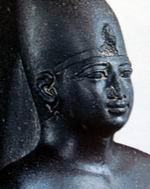 Son
and successor of Tuthmosis III by queen Meritre, ruled alongside
with his father as co-regent. In Manetho’s opinion he ruled 25 years
and 10 months (Flavius). Warlike and cruel king, made numerous
campaigns in Asia. The documents record unusual physical strength
and sporting pursues – bowing, horse riding, rowing and running.
Well known from successful punishing of revolting tribes., from his
first Asiatic campaign he returned with seven conquered princesses.
Six of them were hung down along the Theban walls, the seventh being
hung down at Napata. As an effect of his campaign at the year 9 of
his reign he captured unusually high number of prisoners – 80
thousand. It is believed that this number comprises all captives
from his father’s, Tuthmosis III, campaigns. Amenhotep moved
southern boundaries as far as to Napata where he built a fortress.
Stela of Konosso records an expedition in the year 8 of his rule. He
extended a temple at Karnak and erected funerary temple to the north
of Ramesseum. He built also at heliopolis, Koptos, whole Theban nome
and south, at el-Kab, on Elephantine, Sehel, Kalabsha, Buhen and
more. Died aged 45-50. Son
and successor of Tuthmosis III by queen Meritre, ruled alongside
with his father as co-regent. In Manetho’s opinion he ruled 25 years
and 10 months (Flavius). Warlike and cruel king, made numerous
campaigns in Asia. The documents record unusual physical strength
and sporting pursues – bowing, horse riding, rowing and running.
Well known from successful punishing of revolting tribes., from his
first Asiatic campaign he returned with seven conquered princesses.
Six of them were hung down along the Theban walls, the seventh being
hung down at Napata. As an effect of his campaign at the year 9 of
his reign he captured unusually high number of prisoners – 80
thousand. It is believed that this number comprises all captives
from his father’s, Tuthmosis III, campaigns. Amenhotep moved
southern boundaries as far as to Napata where he built a fortress.
Stela of Konosso records an expedition in the year 8 of his rule. He
extended a temple at Karnak and erected funerary temple to the north
of Ramesseum. He built also at heliopolis, Koptos, whole Theban nome
and south, at el-Kab, on Elephantine, Sehel, Kalabsha, Buhen and
more. Died aged 45-50.Burial place - tomb KV35 at the Valley of the Kings, under Pinedjem I it became the cache for other royal mummies. Other Dating 1454-1419 (Redford) |
|
|
Thutmose IV |
|
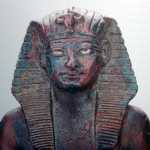 Son
of Amenhotep II and queen Tia. According to Manetho he ruled 10
years. There exists some evidence pointing at disputes around his
succession. He was not as warlike as his predecessors. There is
known fact of expedition to Nubia and inspection in Asia in his 8
year of rule. He tried to run peaceful policy of dyplomacy that
succeeded with treaty with Mitanni. His royal wife was Amenhotep
III’s mother - Mutemweye, the daughter of Mitannian king Artatamas
I. Foreign policy is characterized by accepting and bringing up
Asiatic princes at Egyptian court that was helpful at maintaining
healthy relationship between Egypt and Asia. Building activity is
remarkable at Synai, Heliopolis, Giza, Memfis and Sakkara, as well
as in Hermopolis, Abydos, Dendera and Theban district.Burial place –
tomb KV43 at the Valley of the Kings. The king’s mummy was found in
a KV35 tomb-cache of Amenhotep II. Son
of Amenhotep II and queen Tia. According to Manetho he ruled 10
years. There exists some evidence pointing at disputes around his
succession. He was not as warlike as his predecessors. There is
known fact of expedition to Nubia and inspection in Asia in his 8
year of rule. He tried to run peaceful policy of dyplomacy that
succeeded with treaty with Mitanni. His royal wife was Amenhotep
III’s mother - Mutemweye, the daughter of Mitannian king Artatamas
I. Foreign policy is characterized by accepting and bringing up
Asiatic princes at Egyptian court that was helpful at maintaining
healthy relationship between Egypt and Asia. Building activity is
remarkable at Synai, Heliopolis, Giza, Memfis and Sakkara, as well
as in Hermopolis, Abydos, Dendera and Theban district.Burial place –
tomb KV43 at the Valley of the Kings. The king’s mummy was found in
a KV35 tomb-cache of Amenhotep II.Other Dating 1419-1386 (Wente, van Siclen
III) |
|
|
Amenhotep III |
|
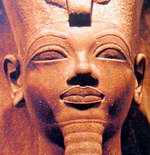 Son
of Tuthmosis IV by queen Mutemweye. It is supposed, though now
doubted by some, that Mutemuje was a Mitannian princess. According
to Manetho, Amenhotep ruled 38 years and 7 months. Great builder and
patron of art and culture. Under his reign, as a result of
many-years conquests of his predecessors, Egypt has been flooded by
uncounted wealth, promoting incredible flourishing of civilization.
Emission of series of scarabs add splendor to his numerous hunting
events. Some expeditions to Nubia and Kush secured continuous
delivery of gold from their mines. He developed diplomacy – peace
with Mitanni and Babylon assured by marriage with daughters of the
rulers of that countries. To his harem got from Mitanni Giluhepa and
Taduhepa, daughters of king Shutarna and his heir, as well as
Babylonian princesses, daughters of Kurgalzu II and
Kadashman-Charbes. His royal chief-wife and mother of his heir was
queen Tiji, presumably daughter of a couple of court nobles – Yuya
and Tjuyu (tomb KV46). Apart from emission of scarabs major
historical value bear documents found in 1887 at Amarna, which are a
part of so called “dyplomatic correspondence”. Three celebrations of
his sed jubilee are known, which took place in years 30, 34 and 37
of his rule. He extended a temple at Karnak, erected magnificent
funerary temple, which was the greatest one in Egypt of that times.
Only two colossal statues are preserved until now (Colossi of
Memnon) and some parts of the temple, like sphinx, stela, and
reminders of figures. This monument had been destroyed due to
earthquake in 1220 BC, thereafter pulled down and stone blocks were
reused to build a funerary temple of Merenptah. At Malgatta he built
splendid palace and many buildings all over Egypt giving the
testimony to the sophisticated taste of the king and his architect
Amenhotep son of Hapu. Apart from the palace at Malgatta and
extending temples in Theban nome there are known numerous temples
and other buildings all over the Land, among others at Bubastis,
Athribis, Heliopolis, Sakkara. In the temple of Mut at Thebes He
ordered to place 600 statues of goddess Sachmet . Attention should
be paid also to the temple of Amun-Re at Soleb, temple of Sobek at
Sumenu and temple of Amenhotep and Tiji at Sedeinga. Son
of Tuthmosis IV by queen Mutemweye. It is supposed, though now
doubted by some, that Mutemuje was a Mitannian princess. According
to Manetho, Amenhotep ruled 38 years and 7 months. Great builder and
patron of art and culture. Under his reign, as a result of
many-years conquests of his predecessors, Egypt has been flooded by
uncounted wealth, promoting incredible flourishing of civilization.
Emission of series of scarabs add splendor to his numerous hunting
events. Some expeditions to Nubia and Kush secured continuous
delivery of gold from their mines. He developed diplomacy – peace
with Mitanni and Babylon assured by marriage with daughters of the
rulers of that countries. To his harem got from Mitanni Giluhepa and
Taduhepa, daughters of king Shutarna and his heir, as well as
Babylonian princesses, daughters of Kurgalzu II and
Kadashman-Charbes. His royal chief-wife and mother of his heir was
queen Tiji, presumably daughter of a couple of court nobles – Yuya
and Tjuyu (tomb KV46). Apart from emission of scarabs major
historical value bear documents found in 1887 at Amarna, which are a
part of so called “dyplomatic correspondence”. Three celebrations of
his sed jubilee are known, which took place in years 30, 34 and 37
of his rule. He extended a temple at Karnak, erected magnificent
funerary temple, which was the greatest one in Egypt of that times.
Only two colossal statues are preserved until now (Colossi of
Memnon) and some parts of the temple, like sphinx, stela, and
reminders of figures. This monument had been destroyed due to
earthquake in 1220 BC, thereafter pulled down and stone blocks were
reused to build a funerary temple of Merenptah. At Malgatta he built
splendid palace and many buildings all over Egypt giving the
testimony to the sophisticated taste of the king and his architect
Amenhotep son of Hapu. Apart from the palace at Malgatta and
extending temples in Theban nome there are known numerous temples
and other buildings all over the Land, among others at Bubastis,
Athribis, Heliopolis, Sakkara. In the temple of Mut at Thebes He
ordered to place 600 statues of goddess Sachmet . Attention should
be paid also to the temple of Amun-Re at Soleb, temple of Sobek at
Sumenu and temple of Amenhotep and Tiji at Sedeinga.Burial place – tomb WV22 in Western Valley of the Kings. King’s mummy was found in the tomb of Amenhotep II - cache KV35. Other Dating 1410-1372
(Redford) |
|
|
Akhenaten |
|
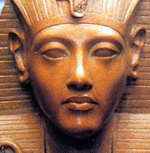 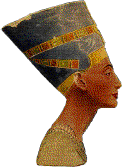 Son
of Amenhotep III and queen Tiji. The most controversial personage in ancient
Egypt history, subject of most animated discussions. In his third year of
rule he started building a huge temple of Aten at Thebes, east to the temple
of Amun at Karnak. In year 4 of his rule he dismissed the high priest of
Amun, Maya, and introduced a new religion instead of cult of Amun. The first
phase of religious revolution was marked with destructions of deities
connected to cult of death, leaving the solar deities untouched. In year 5
he moved the capital from Thebes to Akhet-Aten (Horison of Aten), which
borders were assigned by 14 steles. At the same time he changed his name to
Ax-n-itn (Ray [Glare] of Aten) as well as the whole royal titulary. Other
gods, initially tolerated, now became being abolished with all possible
measures, Akhenaten propagated a cult in the only one god, the solar disc –
Aten, thus giving rise to the first monotheistic religion in the history.
Absorbed absolutely with introducing the new religion and abolishing the old
deities, he neglected completely foreign policy, loosing Egyptian
possessions in Asia and on the south, as well as internal economy. Recently
there is assumed that Ekhnaten did not neglect foreign policy – penalty
expedition at Nubia, plans of Asiatic expedition. The truth is that
possessions at Syria were lost after Ekhnaten’s death. Profound religious
changes found their reflection in art works of Amarna period. The canon
prevailing so far in art and presentations has been abandoned. He had 6
daughters with Nefertiti, a beautiful queen (possibly of Asiatic origin). At
the end of his rule he took into partnership on the throne in a co-regency
his step-brother (son, as others claim) Semenchkare, to whom married his
eldest daughter Merytaten. Particular figure of the king, known to us from
ancient paintings and sculpture made experts in medicine to suggest that the
ruler suffered from genetic disorder called Marfan (Frohlich) syndrome. All
in all, one should realize that similar effects those observed in
Akheneaten’s presentations (long limbs, and face, spindly fingers and fat
around hips, swollen belly) may result from other disorders as well and the
truth could be learned only after examination of the king’s mummy. This
however has been lost in dark shades of history. There is opinion that after
Akhenaten’s death the rule was held about one year by his daughter-wife
Merytaten, who marrying Semenkhkare made him the ruler. Nothing is known as
to , circumstances of his death, he was presumably buried at Akhet-Aten in
the tomb TA26 and later might have been moved to the Valley of the Kings.
Some scholars (Reeves, Dodson) assume that corpse found in KV55 tomb do not
belong to Smenkhkare but to Akhenaten. Son
of Amenhotep III and queen Tiji. The most controversial personage in ancient
Egypt history, subject of most animated discussions. In his third year of
rule he started building a huge temple of Aten at Thebes, east to the temple
of Amun at Karnak. In year 4 of his rule he dismissed the high priest of
Amun, Maya, and introduced a new religion instead of cult of Amun. The first
phase of religious revolution was marked with destructions of deities
connected to cult of death, leaving the solar deities untouched. In year 5
he moved the capital from Thebes to Akhet-Aten (Horison of Aten), which
borders were assigned by 14 steles. At the same time he changed his name to
Ax-n-itn (Ray [Glare] of Aten) as well as the whole royal titulary. Other
gods, initially tolerated, now became being abolished with all possible
measures, Akhenaten propagated a cult in the only one god, the solar disc –
Aten, thus giving rise to the first monotheistic religion in the history.
Absorbed absolutely with introducing the new religion and abolishing the old
deities, he neglected completely foreign policy, loosing Egyptian
possessions in Asia and on the south, as well as internal economy. Recently
there is assumed that Ekhnaten did not neglect foreign policy – penalty
expedition at Nubia, plans of Asiatic expedition. The truth is that
possessions at Syria were lost after Ekhnaten’s death. Profound religious
changes found their reflection in art works of Amarna period. The canon
prevailing so far in art and presentations has been abandoned. He had 6
daughters with Nefertiti, a beautiful queen (possibly of Asiatic origin). At
the end of his rule he took into partnership on the throne in a co-regency
his step-brother (son, as others claim) Semenchkare, to whom married his
eldest daughter Merytaten. Particular figure of the king, known to us from
ancient paintings and sculpture made experts in medicine to suggest that the
ruler suffered from genetic disorder called Marfan (Frohlich) syndrome. All
in all, one should realize that similar effects those observed in
Akheneaten’s presentations (long limbs, and face, spindly fingers and fat
around hips, swollen belly) may result from other disorders as well and the
truth could be learned only after examination of the king’s mummy. This
however has been lost in dark shades of history. There is opinion that after
Akhenaten’s death the rule was held about one year by his daughter-wife
Merytaten, who marrying Semenkhkare made him the ruler. Nothing is known as
to , circumstances of his death, he was presumably buried at Akhet-Aten in
the tomb TA26 and later might have been moved to the Valley of the Kings.
Some scholars (Reeves, Dodson) assume that corpse found in KV55 tomb do not
belong to Smenkhkare but to Akhenaten.Other Dating 1397-1387 (Vandersleyen) |
|
|
Tutankhamen |
|
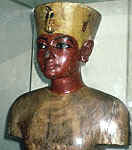 In
spite of a discovery of almost untouched tomb (KV62) in the Valley of the
Kings, our knowledge concerning this king is rather scant. The proposed
genealogy of this epoch is based mainly on speculations and suppositions.
Tutankhamun might have been a son of Semenkhkare by one of numerous
princesses (Merytre?) from Amenhoteps’ court. He might have been even a son
of Amenhotep III and queen Tiye. In this case however some corrections of
the dating of this period should be done. Especially duration of Amenhotep
III and IV regencies needs to be extended. It is believed that his first
years of rule he spent in Akhetaton, then moved the court, or part of this,
to Memphis that was much more suitable for ruling over the land because of
its convenient location. Despite, building activities of this ruler were
focused mainly in Theban region and Nubia. In J. van Dijk’s opinion,
Tutankhamun died at the end of August and was buried at the beginning of
November. There is prevailing opinion that at moment of his death he was
18-19 years old, however some others suggest 23-27 years of age. Recently
promoted theory that Tutankhamun was murdered by his successors does not
seem to have any reasonable justification. All in all, any supporting
evidence is missing In
spite of a discovery of almost untouched tomb (KV62) in the Valley of the
Kings, our knowledge concerning this king is rather scant. The proposed
genealogy of this epoch is based mainly on speculations and suppositions.
Tutankhamun might have been a son of Semenkhkare by one of numerous
princesses (Merytre?) from Amenhoteps’ court. He might have been even a son
of Amenhotep III and queen Tiye. In this case however some corrections of
the dating of this period should be done. Especially duration of Amenhotep
III and IV regencies needs to be extended. It is believed that his first
years of rule he spent in Akhetaton, then moved the court, or part of this,
to Memphis that was much more suitable for ruling over the land because of
its convenient location. Despite, building activities of this ruler were
focused mainly in Theban region and Nubia. In J. van Dijk’s opinion,
Tutankhamun died at the end of August and was buried at the beginning of
November. There is prevailing opinion that at moment of his death he was
18-19 years old, however some others suggest 23-27 years of age. Recently
promoted theory that Tutankhamun was murdered by his successors does not
seem to have any reasonable justification. All in all, any supporting
evidence is missingOther Dating 1355-1346 (Redford) |
|
|
Eye |
|
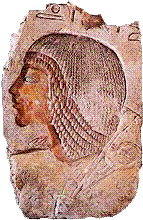 There
is scanty evidence for descent of this pharaoh. Experts in Amarna
period state he was father of queen Mutnedjemet and, probably, of
Nefertiti. It is also possible that he was brother of queen Tiji and
son of a couple of court nobles: Yuya and Tjuyu (tomb KV46). Ay
himself came presumably from Akhmim, where he was born about the
time Amenhothep III was ascending the throne. In times of Akhenaten
and his direct successors he held numerous honorable and responsible
functions but his most important title was iti-nTr, the God’s
Father, which after overtaking a rule was placed even in the royal
cartouche. Under reign of the minor Tutankhamun he held an office of
vizier and regent and he actually held the rule over the land. After
heirless death of Tutankhamun he became the king of Egypt, however
for a short time. A theory of more rapid overtaking of the rule (van
Dijk) in consequence of an attempt on his predecessor’s life is not
convincing enough. Results of his building activities are for all:
mortuary temple at Thebes, chapels at Achmim and Abydos and
buildings at Karnak and Luxor. There is an official tomb of Ay at
Amarna, built under Ekhnaten. His true burial place is tomb WV23 in
the western Valley of the Kings. There
is scanty evidence for descent of this pharaoh. Experts in Amarna
period state he was father of queen Mutnedjemet and, probably, of
Nefertiti. It is also possible that he was brother of queen Tiji and
son of a couple of court nobles: Yuya and Tjuyu (tomb KV46). Ay
himself came presumably from Akhmim, where he was born about the
time Amenhothep III was ascending the throne. In times of Akhenaten
and his direct successors he held numerous honorable and responsible
functions but his most important title was iti-nTr, the God’s
Father, which after overtaking a rule was placed even in the royal
cartouche. Under reign of the minor Tutankhamun he held an office of
vizier and regent and he actually held the rule over the land. After
heirless death of Tutankhamun he became the king of Egypt, however
for a short time. A theory of more rapid overtaking of the rule (van
Dijk) in consequence of an attempt on his predecessor’s life is not
convincing enough. Results of his building activities are for all:
mortuary temple at Thebes, chapels at Achmim and Abydos and
buildings at Karnak and Luxor. There is an official tomb of Ay at
Amarna, built under Ekhnaten. His true burial place is tomb WV23 in
the western Valley of the Kings.Other Dating 1346-1343 (Redford) |
|
|
Horemhab |
|
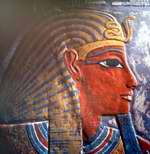 He
originated probably from family of nobles living near Amarna. Under
Akhenaten reign he served as a general of army and enjoyed from the
king many honours. At those times his name was Paatenemheb (Aten Is
Present In Jubilation). Under Tutankhamen he held numerous important
offices and he was also a regent of the young king. Aged 45-55,
after Ai II death, he ascended the throne although not without
support of priests of Amun. It happened during the Theban Opet
festival that he became officially confirmed by the god Amun. He put
efforts to erase from Egyptian history the whole Amarna period,
among others by assigning start point of his own regnal years to
death of Amenhotep III and by destroying images of immediately
preceding him pharaohs. There are known facts of carrying out
materials of Amarna temple for his own building projects. The
central collonade of the great hypostyle at Thebes as well as pylon
2, 9 and 10, completion of collonade at Luxor and rock-temples at
Nubia are only part of widely performed building activities of
Horemheb. Presumably he made war campaign in Asia thus beginning
policy of great conquests, continued by his followers. There is no
consensus among egyptologists as to the length of Horemheb’s rule.
Presumably he reigned 13-28 years. He apponted his heir to the
throne his faithful military companion and vizier – Paramessu. He
build his mastaba in Saqqara however after he became pharaoh he
ordered to cut a tomb KV57 in the Kings’ Valley. He
originated probably from family of nobles living near Amarna. Under
Akhenaten reign he served as a general of army and enjoyed from the
king many honours. At those times his name was Paatenemheb (Aten Is
Present In Jubilation). Under Tutankhamen he held numerous important
offices and he was also a regent of the young king. Aged 45-55,
after Ai II death, he ascended the throne although not without
support of priests of Amun. It happened during the Theban Opet
festival that he became officially confirmed by the god Amun. He put
efforts to erase from Egyptian history the whole Amarna period,
among others by assigning start point of his own regnal years to
death of Amenhotep III and by destroying images of immediately
preceding him pharaohs. There are known facts of carrying out
materials of Amarna temple for his own building projects. The
central collonade of the great hypostyle at Thebes as well as pylon
2, 9 and 10, completion of collonade at Luxor and rock-temples at
Nubia are only part of widely performed building activities of
Horemheb. Presumably he made war campaign in Asia thus beginning
policy of great conquests, continued by his followers. There is no
consensus among egyptologists as to the length of Horemheb’s rule.
Presumably he reigned 13-28 years. He apponted his heir to the
throne his faithful military companion and vizier – Paramessu. He
build his mastaba in Saqqara however after he became pharaoh he
ordered to cut a tomb KV57 in the Kings’ Valley.Other Dating 1343-1315 (Redford) |
|